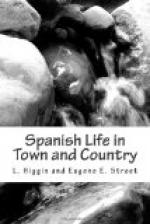The article was illustrated with numerous portraits of Don Rafael: in full torero dress in 1886; his very last photograph; views of him in the courtyard of his home in Cordoba, and outside the Venta San Rafael, where he took his coffee in the evening, and others. The notice concludes by saying that his life was completely dedicated to his property, which he managed himself, and he was looked upon as the guardian angel of the labourers on his farm. Probre Rafael! “The lovers of the bull-fight are lamenting the death of the torero, but the poor of Cordoba mourn the loss of their ‘Senor Rafael.’”
[Illustration: PLAZA DE TOROS. THE PROCESSION]
The wives of the toreros are generally celebrated for their beauty, their wit, and their devotion to their husbands—indeed, the men have a large choice before them when choosing their helpmates for life. To their wives is due much of the making and all the keeping up of the elaborate and costly dress of the torero. They are, as someone has said, “ferociously virtuous,” and share in the open-handed generosity of their husbands. The earnings of a successful torero are very large. In some cases, they make as much as L4000 or L5000 a year of English money, during the height of their popularity, and retire to end their days in their native and beloved Andalucia.
Whatever may be said by foreigners of the brutalising effect of the Spanish popular game, it certainly has no more effect on those who witness or practise it than fox-hunting has on Englishmen, and it is doubtful whether there is any more cruelty in one sport than in the other. The foxes are fostered and brought up for the sole purpose of being harried to death, without even a semblance of fair play being allowed to them, and if a fox-hunter risks his life it is only as a bad rider that he does so. There is no danger and certainly no dignity in the English sport, even if it indirectly keeps up the breed of horses.
A curious incident is related by Count Vasili as having happened in the Bull-Ring in Madrid some years ago during a corrida of Cuchares, the celebrated espada. It is usual during fiestas of charity to enclose live sparrows in the banderillas which it is part of the play to affix, at great risk to the torero, in the shoulders of the bull; the paper envelope bursts, and the birds are set at liberty. Crossing the arena, one of the men carelessly hit at a bird turning wildly about in its efforts to escape, and killed it. “In my life,” says the Count, “I have never seen such a spectacle. Ten thousand spectators, standing up, wildly gesticulating, shouting for death on the ‘cruel torero’; nay, some even threw themselves into the arena, ready to lynch the heartless creature!”
Horse-racing may now be said to have been fairly established in Spain in most of the great centres, and the Hippodrome in Madrid is little behind one of England’s popular race-courses in its crowds, the brilliant dresses of the ladies, and the enthusiasm evoked; but whether it will ever supersede the really national fiesta is to be doubted. The upper classes also affect polo, tennis, and croquet, and go in a good deal for gymnastics, fencing, and fives.




